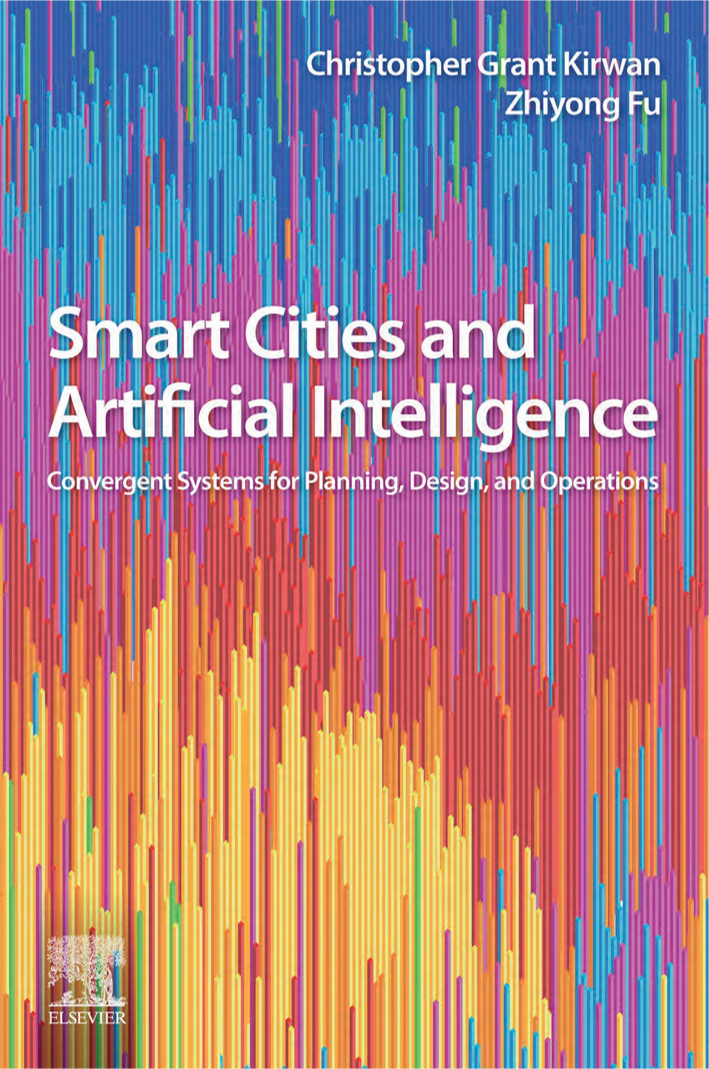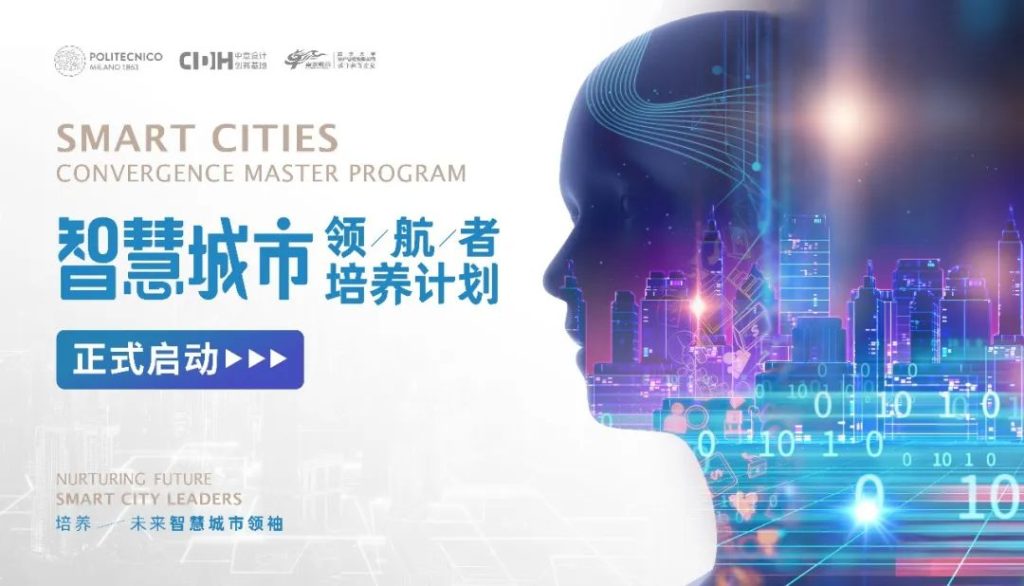

Professor Christopher Grant Kirwan, the Italian Co-Academic Director of the Smart Cities Pilot Training Program, and Associate Professor Zhiyong Fu, the Chinese Co-Academic Director of the Program, released their joint book "Smart Cities and Artificial Intelligence". The book, written over two years, combines the different understandings of "smart cities" from Chinese and Western cultures, and explores the concept of smart city design and development; how the co-intelligence of human-machine and natural systems can transform cities in the context of artificial intelligence; illustrates complex smart city systems and solutions through numerous diagrams; and introduces The presentation also illustrates complex smart city systems and solutions through numerous illustrations, and introduces various smart city cases and initiatives around the world.
Smart Cities and Artificial Intelligence provides a comprehensive view of how cities are evolving into smart ecosystems through converging technologies such as machine learning, neural network functions, geospatial intelligence, data analysis and visualization, sensors, and smart connected objects. that recent advances in artificial intelligence technologies are enabling systems such as urban transportation infrastructure and information networks to develop better urban operating systems that enable the simulation of original patterns of people, machines, and the environment.Provides readers with both a conceptual and practical knowledge base to help them master and apply the key principles required for smart city planning, design and operations.
This book integrates a multidisciplinary theoretical approach to investigate the mechanisms of integration between the digital and physical worlds, and further explores how human-computer co-intelligence can transform the experience of urban environments. It comprehensively presents a new understanding of smart cities through interrelated elements of planning theory and design methods, system architecture, and functional applications of smart cities, with the ultimate goal of making cities more livable, sustainable, and self-sufficient.
Content Highlights
Â- Explore the concept of smart city design and development, and the integration of human, machine and natural systems to transform cities through artificial intelligence (AI).
Â- Numerous diagrams to illustrate and explain complex smart city systems and solutions.
Â- Showcase diverse smart city cases and initiatives from around the world.
About the author.
Christopher Grant Kirwan
Christopher Grant Kirwan
Co-Academic Director, Smart City Leaders Training Program
Visiting Professor, GSOM School of Management, Politecnico di Milano
Christophe is a multidisciplinary professional and academic with over 30 years of experience in a variety of fields including urban planning, architecture, technology and media, with a special focus on the integration of the physical and digital in the context of smart cities. He completed his graduate studies at the Massachusetts Institute of Technology and has been a visiting professor at Harvard University and Tsinghua University. He has authored numerous articles on smart cities and urban operating systems.
Fu Zhiyong
Long-term Associate Professor, Department of Information Art and Design, Academy of Fine Arts, Tsinghua University
Deputy Director of Tsinghua University Sino-Italian Design Innovation Base, Deputy Director of China Innovation and Entrepreneurship Education Research Center, Director of Tsinghua University Art and Technology Innovation Base, Secretary General of Information and Interaction Design Special Committee of China Industrial Design Association, President of World Chinese Overseas Chinese Human-Computer Interaction Association
He has more than 20 years of teaching and research experience in the fields of information design, interaction design, service design and social innovation related to human-machine interfaces and smart cities. His commitment to educational program development and cross-institutional collaboration has led to the establishment of workshops, innovation labs and special joint research projects around the world.
Preamble
There is a reason why the universe converges. We live in cycles of ebb and flow, regulating the rhythm of life as it evolves toward a singularity state. We can think of nature as a building in which, as a living organism, humans reside, contribute, participate and influence. As Alan Watts put it in one of his monologues, "we are just a bad case of dandruff on the planet." The question is the magnitude of the devastation this causes, and whether we have enough sense to reverse the current systemic disease, or even have a positive innovation for the planet.
As Norbert Weiner describes in his book The Human Use of Human Beings, the Earth has reached the peak of its life cycle and is in a pre-entropic state. Present-day resilience is seen as a remedy to stop this process. In the human life cycle, resilience means effectively slowing down the inevitable process of decay.
In addition to the biotechnological environmental challenges we face, the socio-economic dimension of human sustainability and self-actualization is perhaps an even greater obstacle that may prevent humanity from advancing to new levels of enlightenment. A higher state will not be successfully achieved without a better distribution of wealth and resources for all life on Earth, which will continue to accelerate our own human demise.
As the world's population concentrates in cities, they will be the new space for global resource allocation and the training ground on the battlefield. Ironically, we increase the density of densely populated areas and reduce the space for survival, rather than reverse the dispersal of populations based on the information, markets and resources available through digital networks.
This marks a new world order that requires design solutions to address the specific and global problems created by cities. Convergence explains how different species have evolved to have similar characteristics. Technology will be the unifying factor in the realization and operational control of all cities elevated to the level of convergence. However, each city has unique characteristics that reflectCity DNAThe concept that determines the speed and type of technological mastery and management necessary. The current world remains divided between economic and trade systems that polarize individual and collective interests and hinder global cooperative solutions.
Because of the current global hyper-connectivity, the ability of governments, markets and society to develop international standards and regulations to govern resources and design solutions will become even more necessary. This leads to the need for co-creation and co-design approaches to align, integrate and develop widely accepted solutions. As a resultWe need to develop and manage system architecture through global collective intelligence, and there is a convergence of understanding of shared design between East and West.
This book illustrates the collective design process between two cultural circles, political systems, and individual understandings. The collaboration between the authors over the past 10 years demonstrates an attempt to gain shared values, common interests, and a drive to advance ideas and solutions.Enables us to manage the integration process more effectively through interdisciplinary and cross-cultural efforts.
The next stage of the evolutionary process will beArtificial Intelligence Accelerated Development Solutions, which is absolutely necessary to guard against global pre-entropy and the potential collapse of cultures and societies. We pursue a combination of design thinking and machine learning that connects people and technology in the flow of data and problem solving processes to achieve an optimal state of convergence. The ideal outcome is a combination of human well-being, natural system balance, and technological optimization. It is the search for convergence as a natural evolutionary process that will once again bring humans closer to living in harmony with nature. This entails the formation of a collective intelligent network that will help cities to self-regulate as part of the Earth's natural ecosystem, the ultimate goal and stable state of convergence. Along the path of convergence, many new combinations and hybrids will attempt to define and design sustainable directions, includingHuman-computer collaboration, new forms of human-computer behavior, and new pattern languagesThese languages have shifted from a human-centered focus to a higher evolutionary stage of building human-computer natural awareness.
We have positioned this book as a way of getting throughCombining academic research and professional approaches to the emerging field of smart cities, appealing to a wide audience from students to practitioners - today remains a somewhat elusive and all-encompassing era. The evolving conversation around smart cities represents both marketing hype and slow progress in reality, while the demand for creativity, technical expertise and development advances across multiple industries and professions is growing rapidly, all vying for a slice of the projected $1.5 trillion project.
Today, January 1, 2020, begins a new decade that demonstrates a clear vision and future insight in the highly anticipated year 2020, where we are now firmly rooted in the process of integrating technology, humans and nature in a way that has never been seen before in human evolution. This process is both necessary and part of an evolutionary medium that will enable humanity to manage the planet's resources and its own impacts in a more efficient, harmonious way.
Smart City Leaders Training Program Launched

In November 2022, the famous Italian university Politecnico di Milano initiated the establishment of the Sino-Italian design innovation base to provide academic support, and by the Tsinghua University Asset Management Co., Ltd's Zhuoer Education is responsible for providing operational services"Smart City Leaders Training Program"Official launch.
The program brings together leading academic and industry resources from China and Italy to provide an interdisciplinary educational concept that combines theory and practice from a wide range of design, technology, business and management disciplines applicable to smart cities, and is the first cross-cultural education program in the world to be created by a Sino-European institution with a true focus on training future smart city leaders.
The program's Chinese and Italian co-academic directors are Christopher Grant Kirwan and Zhiyong Fu respectively, and the program's faculty brings together two prestigious universities, Politecnico di Milano and Tsinghua University, as well as experts and business leaders in the field of smart cities. They are also well versed in the future development trend of smart city construction.

